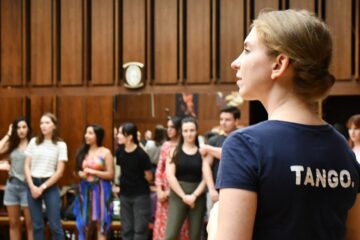With this article we’re kicking off a new series exploring every aspect of tango shoes. Why do we even need them for dancing (spoiler: you don’t necessarily need special tango shoes 😉), which other dance shoes have proven useful for tango, what to keep in mind when buying a pair, and more.
Whether you’ve just started an Argentine tango course or you’ve been part of the tango community for a while, if you have any shoe-related questions or topic ideas, share them with us – we’ll be happy to answer them in a future article!
Why do we use dance shoes?
Do you remember your very first tango class? Most people arrive in sneakers or some other comfortable street shoes – because “you can dance in anything,” right? Then comes our first question: “Did everyone change shoes?” And soon after, the first pivots and ochos… and it turns out something doesn’t feel right.
The shoe either sticks too much or slips like crazy, your steps feel heavy because the sole isn’t flexible enough, and on top of that you can’t really feel the floor – even though we keep telling you: “Puuush the floor.”
That’s exactly why dance shoes exist! They’re not only beautiful and elegant, but they open up a whole new world: they let you move more freely, support your feet properly, and give you a brand new sensation of connection with the floor.
Sounds good? Let’s take a closer look and discover the secrets of dance shoes!
Why aren’t street shoes enough?
Street shoes aren’t made for the dance floor:
- Their soles often stick too much, or the opposite happens and you feel like you’re on an ice rink (that’s rarer) – neither version helps with tango pivots.
- They’re much stiffer and don’t allow your foot to move flexibly, which means you lose the lightness of dancing – and that lightness, that joyful harmony of moving together with your partner, is one of the best parts of social dances.
- Their heels are often unstable, supporting your weight in the wrong place, with a structure not designed for dancing → higher risk of injury, especially if your ankles are weaker.
- And let’s not forget: street shoes bring in dirt, mud, or small stones – everything that ruins the floor and everyone else’s dance shoes ☹
Why is a dance shoe better?
Every little detail of a dance shoe is designed for dancing:
- The suede sole helps you spin while giving just the right amount of grip for the refined yet dynamic tango walk.
- Light and flexible, it lets you really feel the floor.
- It fits snugly, holding your foot securely – no slipping, no pinching.
- The heel gives stability, supporting you in the right place, making your steps more grounded and safe.
- And of course: they’re gorgeous. In beautiful shoes you feel better on the dance floor and move with more confidence.
At the very least, bring indoor shoes
If you don’t have your own pair of dance shoes yet, bringing a clean pair of shoes you only use indoors already makes a big difference:
- The floor will thank you for not dragging in outside dirt.
- You’ll feel better too – lighter and cleaner.
- It’s a gesture towards the community: you’re showing respect for others and for the venue.
- Ideally, your indoor shoes should be light and flexible – that helps your movement the most.
Why does all this matter?
Because in dance, every little detail counts. A good shoe is not only more comfortable and safer, but it also brings you closer to that magical feeling when movement and music become one.
And if you’re asking now: “Okay, but which dance shoe should I choose?” – we’ll look at that in the next part of the series 😉 In the meantime, we’d love to welcome you to our English speaking beginner tango classes in Budapest – even if you come without a partner!


